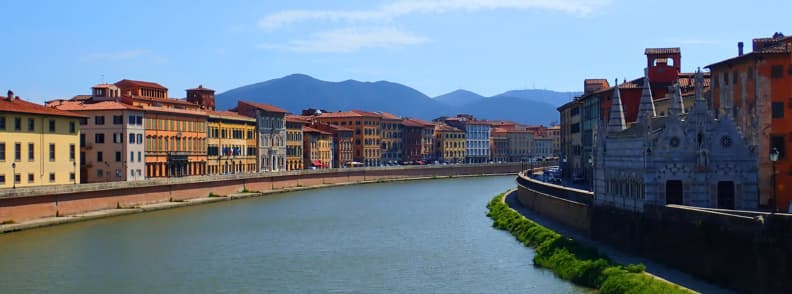Sailing to Pisa isn’t something most people think is possible. But it is, and it’s unforgettable. 12 days into our Mediterranean sailing trip in 2020, we navigated up the Arno River, leaving the calm Ligurian Sea behind to find shelter from approaching bad weather. What followed was a rare experience: steering our sailboat upriver past wooden fishing huts, cottages with boats moored just meters from the door, and into one of Tuscany’s quietest marinas, Nautica 180 Pisa.
This wasn’t a luxury charter or a guided Pisa boat tour. We were doing it ourselves with no VHF call-ins, just WhatsApp messages and a stern-to mooring with a side of river current. The whole thing felt surreal. We obviously jumped on the occasion to also visit Pisa. I’d been to Pisa before, but this approach, through Bocca d’Arno, gave the city a new face. There were no crowds. The Leaning Tower was still standing, but nobody was holding it.
Sailing Up The Arno River to Visit Pisa
If you’re planning to sail the Tuscan coast, or even just looking for an alternative way to visit Pisa, this guide gives you everything you need: real navigation tips, first-hand marina info, what to expect from Arno River sailing, and how to explore Pisa from a boat. You’ll find route planning advice, details about Italian marina services, practical travel logistics, and even what it was like sailing during the pandemic. I’ll also show you how to enjoy Pisa by boat if you’re not sailing yourself, including seasonal Arno River cruises, public transport from Marina di Pisa, and the best half-day walking itinerary into the city.
Whether you’re arriving with your own yacht or just curious about visiting Pisa by boat up the River Arno, this guide is written for you: the sailor, the traveler, the slow explorer.
Disclosure: Some of the links below are affiliate links. This means that at no extra cost to you, The Travel Bunny will earn a small commission if you click through and make a purchase. Thank you!
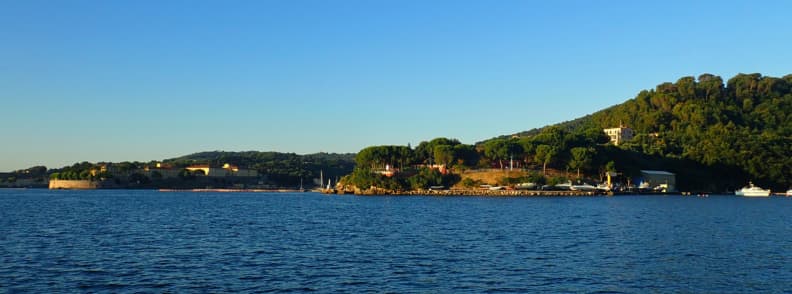
Our Mediterranean Journey from Portovenere to Marina di Pisa
The leg from Portovenere sailing to Marina di Pisa was one of the quietest stretches of our trip, and one of the most surprising. We left early, at 6:30 AM, trying to beat the heat. There was almost no wind, so we motor-sailed a good part of the trip. No pressure. No stress. Fuel use was minimal. And we weren’t in a hurry.
As we left Portovenere, we caught our last views of Isola Palmaria, quiet in the morning light. This is one of those places that stays with you, with the rugged shoreline, anchored boats waking up slowly, and that sense that you’re really far from the noise of everything else. Then we saw it: the only cruise ship we encountered during our entire time sailing Tuscany. It was a very rare sight during the pandemic, I guess it was only relocating.
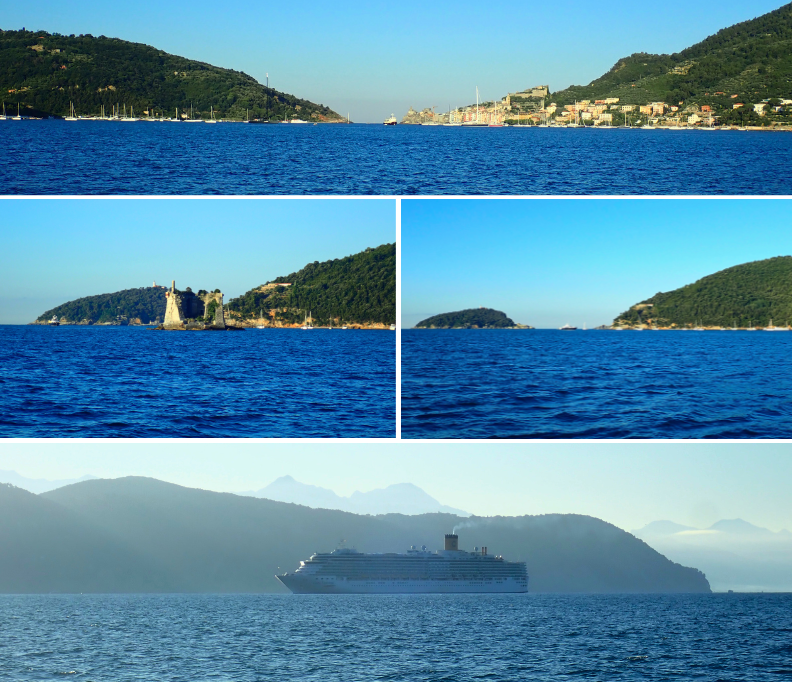
Sailing from Portovenere to Pisa on a Calm, Quiet Route
This part of the sailing Ligurian Sea route is uneventful in the best possible way. No traffic early in the day, no strange currents, and with calm water, it was the kind of passage that lets you notice everything: light shifting on the surface, your partner making coffee, a few gulls floating behind you. We kept a steady average sailing speed yacht Portovenere Pisa of around 5 knots. The distance, depending on how far upriver you go, clocks in at about 35 nautical miles.
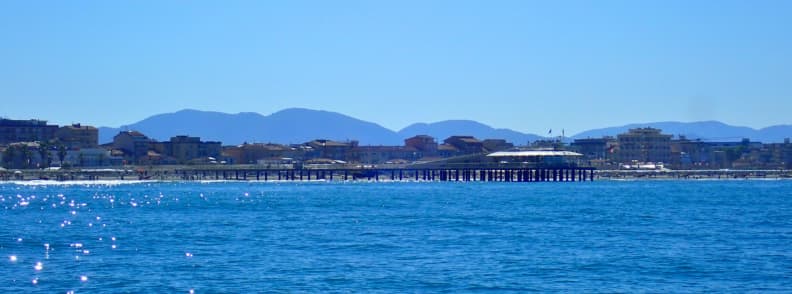
By mid-morning, we passed Viareggio sailing from a distance. I remembered a previous trip there, mainly for one of the best seafood plates I’ve had in Italy: baby squid and deep-fried vegetables, crunchy outside and soft inside. We didn’t stop this time, just admired the coast from the cockpit. The sun was rising, the sails were back up, and we glided along in silence.
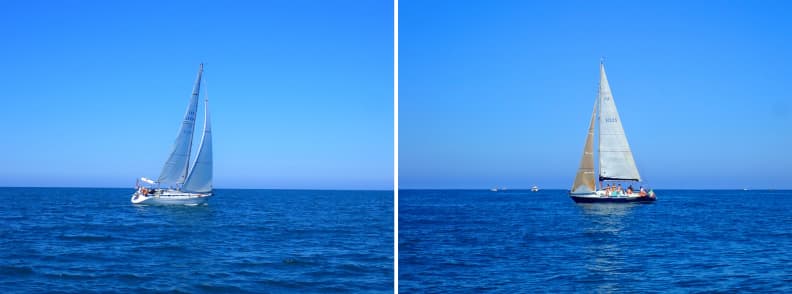
Signs You’re Nearing the Arno: More Sailboats, Less Sea
As we neared Marina di Pisa, the sea started to feel different. Sailboats became more frequent. For hours, we hadn’t seen a single boat, but now, they dotted the horizon. It felt surreal, like the world had turned back on at last. The closer we got to the Tuscan coast sailing harbors, the more active the water became.
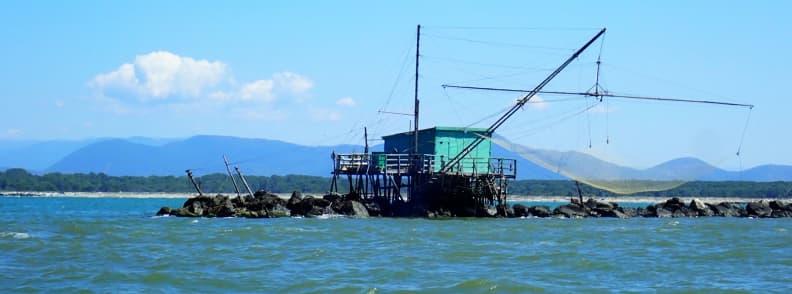
As we reached Bocca d’Arno, we saw them: wooden fishing huts raised on stilts above the water. The Retoni, traditional Italian fishing huts, were like nothing I’d seen before. I was in awe. Some hung nets beneath long wooden arms. Others leaned over the river like old watchtowers. The contrast between the muddy brown of the Arno and the blue of the Ligurian Sea was sharp and strange.
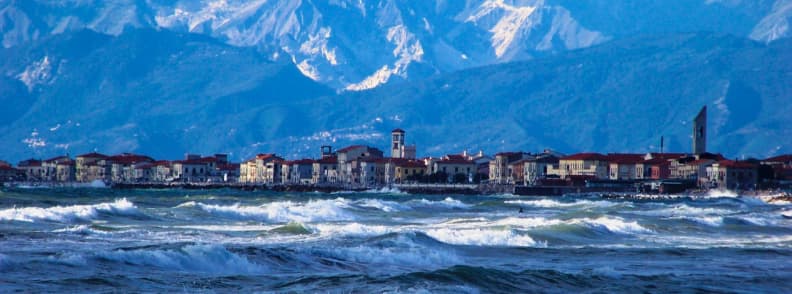
Peaceful and Practical Tips for Approaching Marina di Pisa
For families or slower-paced sailors, Marina di Pisa is one of the better stops along this coast. It’s not too big, not too exposed, and it’s well set up. The harbor feels protected and orderly. Even though we didn’t dock there, we passed close enough to note how different it looked from some of the smaller fishing ports further north or south.
If you’re provisioning, needing to do light repairs, or just want a day off the boat without too much planning, Marina di Pisa gives you that space. And if you’re thinking of visiting Pisa by boat, this is your decision point: stay at the mouth or go upriver.
Local tip: You don’t need to go all the way to Pisa to enjoy this area. If you’re moored at Marina di Pisa, you can take a quick bus into town, find a supermarket nearby, or just spend a quiet evening walking along the seawall. But if the weather’s good and you’re up for something more unique, sailing upriver on the Arno River is something worth doing at least once.
Entering the Arno, Where River Meets Sea
Sailing into the Arno River felt different from any other marina approach we’ve done. The shift is subtle but clear. The open sea behind you disappears fast. You’re suddenly in almost still water, not entirely calm. The Arno River navigation begins immediately after Bocca d’Arno, and this transition zone (estuary, fishing zone, industrial corridor) holds a kind of quiet tension.
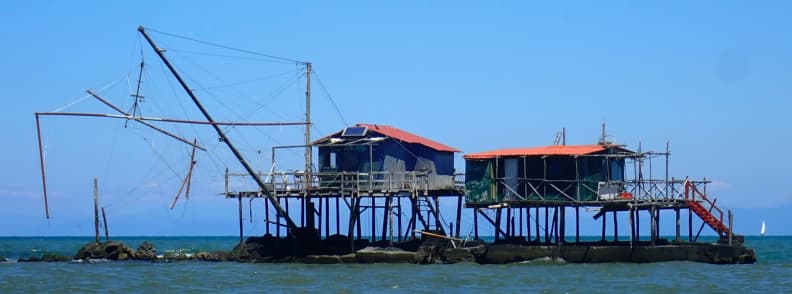
The Retoni Fishing Huts at Bocca d’Arno
Just before we entered the river, we saw the Retoni Bocca d’Arno houses up close. These are traditional Italian fishing huts, built on stilts right above the water, with long wooden arms suspending nets. They looked like relics from another time, but they’re still in use. Most were empty that morning, just creaking softly in the breeze.
If you’ve never seen this kind of setup before, Arno River fishing huts are some of the most distinctive examples in Italy. They’re part of a fishing tradition that dates back to the post-war decades, built by hand, maintained by locals, and still operating today using the same simple methods. Some were barely standing, while others were freshly painted.
Local tip: You can spot the Retoni from land near Marina di Pisa, but the best view is from the water. Sunrise and sunset give them that washed-out golden look photographers love. They’re especially good subjects for those into sailing photography opportunities Tuscany offers beyond the postcard shots.
Salt Meets Freshwater in the Arno Estuary
As soon as we entered the river mouth, the color changed. The sea was still deep blue behind us, but the Arno was a murky brown, stirred up, muddy, opaque. The Arno River freshwater saltwater estuary is where the two meet, and it’s obvious. It looked like someone drew a line in the water. And we passed right over it.
This part of the river sailing Mediterranean experience is unpredictable. Sometimes there’s more pushback from the current, sometimes less. That morning, our Arno River depth for yachts Pisa stretch seemed navigable. Our draft allowed us through without trouble, but we did notice the depth shrinking in some places. Later, further upriver, we’d come to spots where it was borderline.
If you’re planning to go past Marina di Pisa toward Nautica 180, check your charts and not just once. Conditions can change quickly here. What’s printed on the Navionics app may not reflect seasonal silting. Our own experience proved that while Arno River navigation is possible, it’s not something to take for granted.
Do You Need to Time the Tides at Bocca d’Arno?
In our case, no. We didn’t need to wait for tides. The Bocca d’Arno navigation was smooth that day, but this isn’t always the case. The depth near the mouth depends on recent rain, silt accumulation, and, to some extent, the tides. While the river is not particularly tidal this far inland, the estuary still shifts enough to complicate things for boats with deeper drafts.
There are no locks to deal with. But river currents sailing in Italy isn’t a common topic in most cruising guides, and that’s a problem. You need to watch not just your depth, but also how the current plays with your bow, especially if you’re approaching at low RPMs.
Local tip: Reach out directly to Nautica 180 Pisa or Porto di Pisa before entering the Arno. Alessandro at Nautica 180 is responsive by WhatsApp and gave us the real-time info we needed. That contact saved us guesswork and possibly a few extra scratches on the hull.
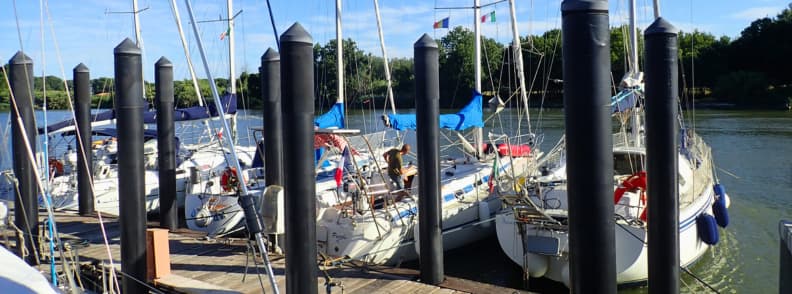
Docking at Nautica 180 Pisa: What Sailors Need to Know
We were already well upriver when we made visual contact with the dock at Nautica 180 Pisa. It’s a small marina on the Arno River, facing the San Rossore Natural Park. There’s no VHF response. Instead, we messaged Alessandro, the owner, on WhatsApp. He was already waiting for us.
This isn’t the usual Med marina experience. It’s quieter, simpler, and more personal. And because of the river current, docking requires a bit of planning, especially if you’re unfamiliar with Mediterranean mooring techniques in flowing water.
Stern-to Mooring in a River Current
Surprisingly, we moored stern-to instead of side-to. That’s standard in Italy, but doing it in a river is a different story. The river currents sailing upriver had felt negligible earlier, but at the dock, it mattered. The current kept nudging the bow away, just enough to throw off your angle if you weren’t paying attention.
Alessandro walked us calmly through the process. One line after another, in the right order. No drama, no yelling, just teamwork between us on the boat and two people waiting on the pier. That made all the difference.
This is where technique comes in. Stern-to mooring requires confidence in reverse, good fendering, and steady throttle control. But add a sideways push from the river, and you need to adjust fast. There’s no shame in backing out and trying again.
River sailing tip: Don’t be surprised if the current doesn’t behave as you expect. You might feel nothing on approach, then suddenly have to fight to hold the bow. Let the marina help you. They know the rhythm better than your depth sounder does.
What to Expect at Nautica 180: Facilities and Quirks
The marina has all the essentials: fuel, water, electricity, and shore power. There’s a technical assistance station, a lifting crane, and the ability to haul out if needed. The dock is calm, and the surrounding nature adds a bit of quiet magic. But it’s not the kind of place where you’ll find bars, shops, or a promenade.
The marina costs Italy comparison puts Nautica 180 Pisa in the lower tier. Prices were fair for what we got, especially given the safe inland position. But be prepared: the showers operate on 1-euro coin tokens, and you’ll need a few if you’re hoping to wash properly. I didn’t know that. My first hot shower ended before I got water on all the hair on my head.
If you’re sailing with kids, the dock itself is stable, but the river isn’t a swimming spot. There’s no obvious playground or fenced area. Still, if your boat is secure and you’ve got warm water onboard, it’s an easy place to stay for a few nights.
Local tip: Bring coins or be ready to skip the marina showers. We found it easier and much warmer to shower onboard. The thermal shock after a short token shower just wasn’t worth it.
Provisioning, Payments, and Staying Self-Sufficient
This is where sailing provisions Italy becomes a topic you’ll care about. Nautica 180 Pisa is isolated. There are no grocery shops nearby. You’ll either need to head into Pisa or Marina di Pisa to get what you need. Mathieu took one of our foldable bikes and rode to Marina di Pisa, and he came back with delicious ripe figs and a few basics.
Cash is king here. That’s another thing we didn’t expect. The marina only takes cash. But Alessandro was patient. He let us head into Pisa to find an ATM and didn’t pressure us to pay right away.
We ate on board during our stay. Not because we were trying to be frugal, but because the area still felt fragile. Northern Italy had been heavily affected by the pandemic, and we preferred to play it safe. We spotted one restaurant not far from the marina entrance, but chose not to go.
Local sailing tip: Before docking here, stock up on groceries and carry cash, ideally 10 to 20 euros in coins and more in notes for the marina fee. If you need an ATM, you’ll find one easily in Pisa city, but not right at the dock.
Arno Sunsets & Sunrises: Slow Travel Moments
If you’re used to marinas full of motion (rigging clanking, music playing, people coming and going), Nautica 180 Pisa feels like an exhale. This is one of the few places where time really slows down. Days feel longer. Nights feel quieter. And the river becomes the main character.
We spent two nights docked here, waiting out bad weather. I didn’t expect to fall in love with the view.
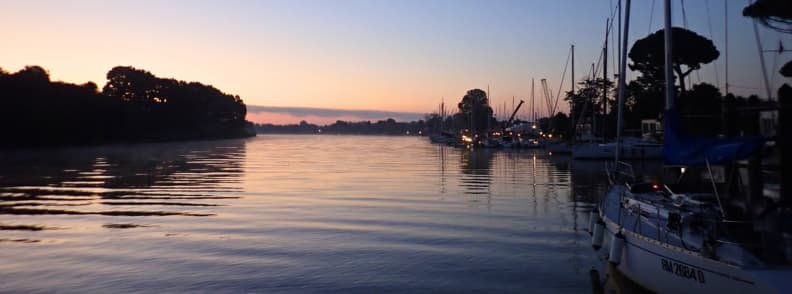
Sunrises on the Arno with Mist and Silence
One morning, I got up just before sunrise. Other sailors had mentioned in their Marina Nautica 180 Navily reviews that you could sometimes see deer across the river, in the San Rossore Natural Park. I didn’t see any that day. But the Arno River sunrise was unforgettable.
There was mist rising off the surface, low, ghostly, and golden. The water moved slowly, like it was half asleep. Not a single person was out. We couldn’t hear any cars, or horns, or shouting. Just birds. I remember seeing swallows diving low over the water. They’d even built nests under the bridge that connects the floating dock to the shore.
Everything was still. That kind of stillness you only get in places that haven’t been overrun. It’s a moment that makes you stop scrolling, stop rushing, stop thinking about what’s next. Just for a bit.
Slow travel tip: If you’re a light sleeper, set your alarm for 5:30 AM. Even if you don’t see deer, the morning light on the Arno River is worth it. Bring a warm layer because the humidity makes it feel cooler than the forecast suggests.
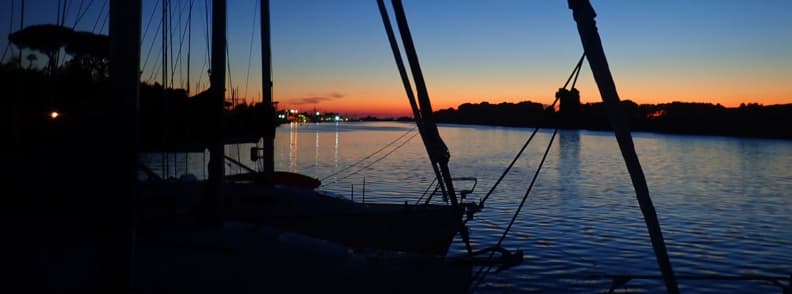
Sunsets with Long Light and a Sense of Enough
Evenings on the Arno are slower than they are at sea. The horizon is closer. The sounds shift. You don’t hear waves anymore, but you do hear the occasional splash of a fish or a line creaking on a nearby boat. The golden hour stretches long. It feels earned.
We stayed onboard both evenings. Cooked simple food. Watched the sky change. We just sat on deck and did nothing. No reading, no writing, barely any talking, while watching the Arno River sunset light tilt slowly behind the trees. These are the things I remember more than any restaurant meal or Instagram moment.
We saw deer eventually. On the day we left to return to the sea, a small group stepped out of the woods on the opposite bank. It was a quiet crossing, like they did it every day.
Photo tip: If you’re into photography, the best light hits around 20 minutes before sunset. For reflections, stand on the bow with the boat’s deck out of frame. For silhouettes, shoot toward the western tree line.
Visiting Pisa Beyond the Tower
Sailing into Pisa changes the way you experience the city. You’re not arriving with a tour group or rushing off a train. You approach it slowly, from the water, with the sun behind you and the river stretching ahead. And when you moor at Nautica 180 Pisa, Pisa itself becomes something you walk into, not something you queue up for.
We took the first bus into the city. It stopped just in front of the marina. A short ride, around 30 minutes, brought us to the heart of it all.
Getting into Town is Easy, Even Without a Car
The bus to Pisa runs frequently from Marina di Pisa and stops near the land entrance of Nautica 180 Pisa. You don’t need to book ahead, and the ticket costs just a few euros. We didn’t even need to show a ticket on our first ride. The driver, behind a plexiglass screen, simply waved us in when we asked him about buying a ticket. It was still pandemic season, and contact was kept to a minimum.
On the way back, the bus was more crowded. Teenagers heading to the beach piled in without masks, and the driver stopped the engine until they all pulled theirs on properly. That moment stuck with me. Everyone had adapted, and the rules were still respected.
Local tip: If you plan to visit Pisa by boat, moor at Nautica 180 Pisa and use the local bus. It’s cheap, easy, and much less stressful than navigating parking or crowds.
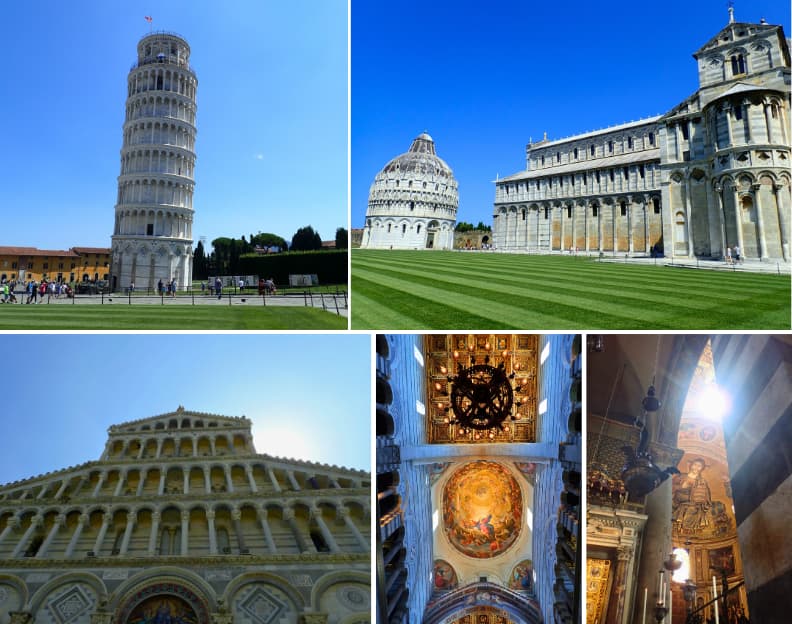
Piazza dei Miracoli was Quieter Than I’d Ever Seen It
This was my second time in Pisa. For my husband, it was the first. We didn’t go up the tower. We didn’t need to. The view from below, without the crowds, was enough. There was nobody posing. Nobody was holding the tower, and somehow it still stood strong. There was just grass, sunlight, and a lot of space.
The Pisa Cathedral, officially the Cattedrale di Santa Maria Assunta, is free to enter, but you still need to stop at the ticket office. There’s usually a line to book a time, and then you wait some more until it’s time to go visit. We walked right in. By the time we came out, a small line had formed, but it was nothing compared to what this square usually sees.
Inside, the architecture is stunning. Marble, mosaics, and echoes that roll across the nave. It’s easy to forget this isn’t a museum. It’s still a working church and a place of quiet for the people who live here.
Smart travel tip: Go early or mid-afternoon. Mid-morning gets the school groups. Entry is free, but times are controlled, so stop at the ticket counter even if there’s no line.
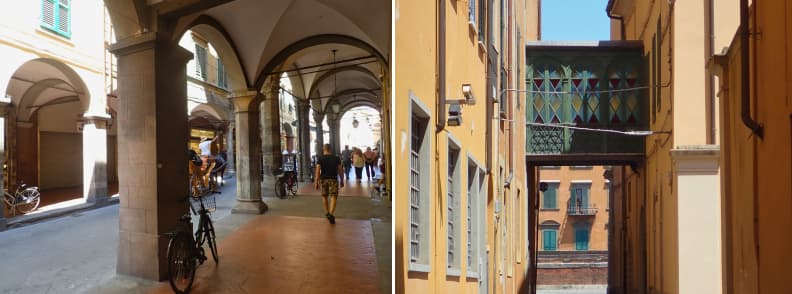
Wandering Back: Murals, Markets, and Quiet Moments in Pisa
We didn’t follow a map. We had two goals: find an ATM, and grab a bite before heading back to Nautica 180 Pisa. The tower behind us, we slipped into the smaller streets, following shade and instinct. Pisa isn’t large, but it folds into itself. Around one corner, the city turns into something more local, more lived in.
We passed shopfronts still shuttered from the lockdown. A bakery with just one kind of bread left. A mother pushing a stroller, mask under her chin, waving to someone across the square. Then we found the alley.
It wasn’t marked on Google, but the walls were filled with murals — some bright, others flaking, all personal. At the entrance, a small plaque read: “In this Alley several Pisan artists have donated their works in the spirit of redeveloping the common space. This path is dedicated to the friend Maurizio Andruetto who has always believed and ideally guided this project…” It felt intimate, unfiltered, and deliberate. Not curated for tourists. Just art where art was needed. That alley said more about Pisa than any postcard.
We kept walking, and somewhere near a local market, I needed a toilet. We found a free public restroom, unmarked, tucked away behind a small building. Clean, quiet, no attendant asking for coins. Just open. I remember standing there, washing my hands, thinking: this is the kind of thing a city does when it trusts people.
Lunch wasn’t special. Pizza from a small trattoria: basic, fast, and forgettable in every way except one. The table had a transparent vinyl sheet over a blue cloth. It reminded me of my grandmother’s kitchen. At the end of the trip, we felt full, a little sunburned, and glad we’d come.
Local travel tip: If you’re walking from Pisa Cathedral back toward the river, pass through Piazza XX Settembre and cross Ponte di Mezzo. It’s a quieter part of town, and you’ll get a good view of the Lungarni, the elegant riverfront promenades Pisa is built around.
Pro travel tip: When you visit Pisa, don’t just follow signs to the Leaning Tower. Let yourself drift through the city. Pisa rewards that kind of traveler. Look for local markets, handwritten menus, and murals without signatures.
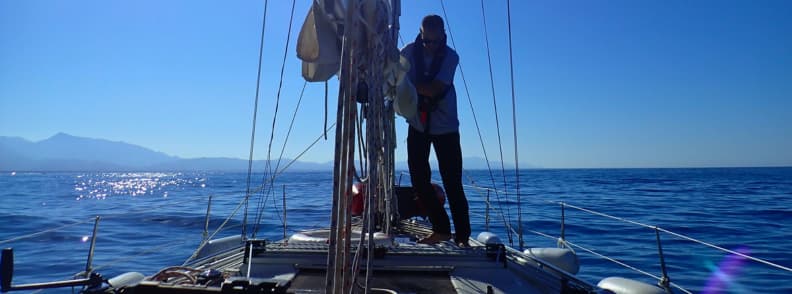
Technical Sailing Logistics & Tips
Sailing to Pisa sounds simple on paper. But like most things in Italy, the reality is layered. Between the estuary, the current, and the lack of formal guidance, you need to arrive prepared, especially if you’re planning to go upriver, past Marina di Pisa, into lesser-charted water.
We didn’t face any problems, but we also knew our limits. The Arno River sailing stretch between Bocca d’Arno and Nautica 180 Pisa isn’t dangerous, but it does demand attention. And if you’re sailing with a child, even one unexpected push from the current can turn into a hassle.
Check the Current More Than Once
Currents in the Arno are unpredictable. We felt almost nothing while coming in. But at the dock, it pulled the bow just enough to make stern-to mooring more complicated. Alessandro at Nautica 180 gave us a heads-up via WhatsApp, and that helped us plan the right angle.
Charts won’t always help here. Depth is variable. Silting happens. And while the Arno River navigation is technically open, it’s not actively managed like a major port. Don’t assume dredging has been done. Conditions change seasonally and even week to week, especially after heavy rain.
Sailing tip: If your draft is more than 2 meters, double-check with the marina before attempting to sail in. Some areas upriver are passable only for shallow-draft vessels. We cleared it fine, but saw areas where others might not.
Weather Planning Along the Tuscan Coast
We chose to sail upriver partly because of sailing weather Italy forecasts. A front was coming in, and we didn’t want to be stuck outside with high winds and choppy swell. Going inland gave us calm waters and time.
The Tuscan sailing season is long, generally April to October, but late summer storms roll in quickly. And the Ligurian Sea doesn’t give you much protection. If you’re unsure about the weather window, the marinas near Pisa are one of the few inland options that feel secure. Sailing emergency shelter Italian rivers isn’t a common concept, but here, it made sense.
Italy sailing tip: Use multiple sources for weather, such as Windy, MeteoMarine, and local port notices. And trust your gut. If it looks unstable on the horizon, the Arno can buy you a few calm days.
Legalities, Licenses, and Common Sense
If you’re not from the EU, double-check your sailing documentation Italy before arrival. A valid ICC (International Certificate of Competence) is usually accepted, but local authorities may ask for proof of insurance, VHF license, and boat registration. We were never stopped, but that’s no guarantee.
For sailing permits Italy, the rules are flexible for recreational use, especially for foreign-flagged vessels. But once you’re on inland waters like the Arno, technically, local rules apply. There’s no formal marina reservation system on this river stretch, so everything is manual: WhatsApp, calls, direct contacts.
We appreciated that. It made the experience feel like sailing used to feel, more informal, human, and responsive.
Italy sailing tip: Keep digital and printed copies of your boat docs. And always have your boat name and length in your first message to a marina. It speeds things up.
Costs and Budgeting: What to Expect
Marina costs Italy vary wildly, but Nautica 180 Pisa was one of the better-priced stops on our route (before crossing to Greece, that is). The facilities are basic, but fair. And while Pisa itself isn’t cheap, staying just outside the city (on the river, in a place with no restaurant or shop) actually saved us money.
We cooked onboard, didn’t spend on attractions, and only paid for transport and a few groceries. For sailing budget Italy planning, this kind of stop adds breathing room.
Budget tip: Expect around €30-€50 per night for a 10-12m boat at Nautica 180, depending on the season. Always ask for the price before tying up. Alessandro is straightforward, but not all marina operators in Italy are.
Cultural Context: Arno’s Fishing Heritage
One of the most striking things you’ll see as you enter the Arno River isn’t architectural or natural. It’s human. The Retoni, those wooden fishing huts on stilts at Bocca d’Arno, are unlike anything I’d seen before.
We passed them early, just after leaving the sea behind. They looked suspended in time, square cabins, long arms stretched out over the water, nets hanging like sails at rest. Some were clean and freshly painted. Others leaned slightly, with rusted ladders and broken boards. All of them imposing.

The Retoni, Icons of Postwar Fishing Culture
These traditional Italian fishing huts started appearing after World War II. Built by local families who relied on the river and the sea, they used simple net systems to catch fish as the tide changed. A pulley would lower the net. Later, the same line would haul it back, heavy with mullet, shrimp, or eels.
The Retoni aren’t tourist attractions. They’re still working huts or at least were, until recently. Some have been passed down through generations. Others are now abandoned or used more for gathering than fishing. They speak to a time when Italian fishing traditions weren’t curated. They were just life.
Sightseeing tip: If you want to see the Retoni up close, the best view is from a boat. From land, you’ll catch them near Marina di Pisa, but from the river, you get their full outline against the sky.
Retoni and the Sailing Mindset
As we motored upriver, I kept looking back at the huts. There’s a rhythm to them that reminded me of sailing: slow, deliberate, built around timing. You drop the net, you wait. You haul, you hope. It’s not efficient, but it’s honest.
I didn’t know then that similar huts exist along the Atlantic coast of France and maybe in other places along the Mediterranean coast. Back then, I thought these were unique to the Arno. And maybe, for me, they still are. It’s one thing to read about traditional Mediterranean sailing methods, and another to pass them in silence, early in the morning, on your own boat.
Culture Beyond the Retoni
As we sailed further upriver, the huts gave way to homes. Modest ones at first, cottages with vines on the fence, laundry hanging, and always, a small boat tied just out front. It was the kind of scene that felt impossible to stage. A lifestyle that most people scroll past without ever knowing it’s real.
This was my first time seeing Italian sailing culture not as a sport or spectacle, but as daily life. People use boats not to escape their day-to-day routine, but to live it.
Photo tip: If you’re heading back to the sea, leave early and pass the huts again at sunrise. The light comes straight across the water, turning everything gold… huts, nets, ropes, the surface of the river itself. It’s the kind of thing you don’t need a camera for, but take one anyway.
Pandemic-Era Sailing in Italy, A 2020 Travel Story
Sailing up the Arno River in 2020 felt like stepping through a door nobody else had noticed was open. We were deep into the first summer of the pandemic — before vaccines, before any real certainty — and sailing became more than a mode of travel. It became a way to live sanely.
Italy had just emerged from a long and painful lockdown. Northern regions had been hit especially hard. In the months before we left, we’d watched the news, heard the sirens, and seen zona rossa maps lit up across Tuscany and Lombardy. So when we finally got to sail, it didn’t feel like a holiday. It felt like permission to breathe again.
Pisa Without the Crowds
When we reached Pisa, I couldn’t believe how empty it was. Piazza dei Miracoli, which normally swells with tourists and street vendors, was silent. Grass, sun, the tower, but nobody posing with their hand out, pretending to hold it up. No queues. No shouting. It was great!
Inside the cathedral, we walked freely. The echo inside the nave seemed longer, like even the architecture had slowed down. It was beautiful and eerie. Outside, a few people milled around. Mostly locals, some domestic tourists. But nothing like the crowds this city is used to.
Masks, Buses, and the New Normal
Getting to Pisa from Nautica 180 Pisa meant taking the local bus. I still remember trying to buy tickets from the driver. He refused to touch money or lose his protection around foreigners; he just nodded and motioned us on. The plexiglass screen separated him from everyone. The ride was silent, cautious, but not unfriendly.
On the way back, the bus was packed. Teenagers heading to the beach crowded in, loud and carefree, none wearing masks. The driver stopped the bus, stood up, and shouted. He refused to drive until every mask was on. And they listened. No complaints. They just did it.
That moment said a lot about Italy in 2020. Tired, yes. But still holding the line.

The Andrà Tutto Bene Year
All across the north, we saw the phrase painted on walls, in windows, on signs: Andrà tutto bene. Everything will be alright. It was more than optimism. It felt like defiance. A quiet way of saying: we’re still here.
Traveling during that time wasn’t light or casual. We disinfected frequently, avoided restaurants, kept our distance. But it also brought a strange kind of closeness with each other, with the places we visited, with the people who still chose to open their doors and/or hearts.
Pro travel tip: If you’re sailing in uncertain times (pandemic, strikes, anything that changes the rhythm of travel), keep a few extra days in your itinerary. It’s not just about logistics. It gives you space to rest when the world feels heavy.
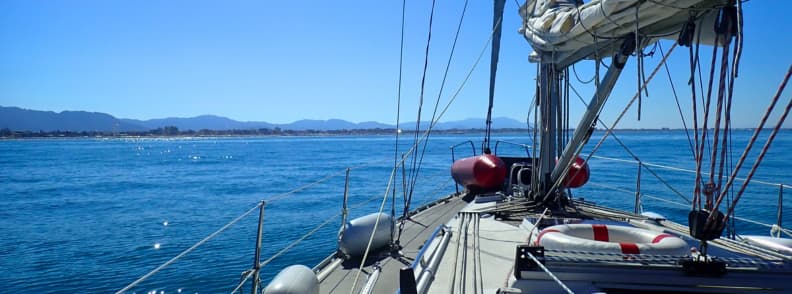
FAQs about Sailing Up the Arno River to Visit Pisa
Even before we sailed up the Arno River, I had questions. A lot of them. Some didn’t have clear answers online, and the ones that did often came from forums or outdated marina sites. Now that we’ve done it, here’s what I would have wanted to know, with honest, experience-backed answers, and a few local tips thrown in.
Can you sail to Pisa?
Yes, you can sail to Pisa, but not all the way to the city centre. You’ll need to enter via Bocca d’Arno and sail upriver to Nautica 180 Pisa or Marina di Pisa. From there, it’s a short bus ride into town.
If your draft is under 2m, you should be fine navigating up the river to Nautica 180 or other marinas like it. Deeper boats should check first.
Is the Arno River navigable for sailboats?
Technically, yes, but it depends on your route, your boat, and the season. The Arno River navigation between Bocca d’Arno and Nautica 180 is calm but shallow in parts. Charts help, but they don’t account for silting or recent rainfall. Always contact the marina (WhatsApp works best) before entering. We messaged Alessandro at Nautica 180 Pisa and got real-time advice.
Where can I dock if I want to visit Pisa by boat?
The best two options are Nautica 180 Pisa (upriver, quiet, small, cash-only, helpful staff) and Marina di Pisa (at the mouth, more facilities, easier access for larger boats). We chose Nautica 180 for its inland protection and peaceful setting.
Do I need a sailing license to sail into Pisa?
If you’re coming from another country, your sailing documentation Italy must include your national boating license (or ICC) and proof of insurance. We weren’t asked for documents, but technically, you’re required to have them on board.
For smaller boats under 40 HP, Italy doesn’t always require a license, but you’ll still want to carry your papers.
How deep is the Arno River at Pisa?
Depth varies by location and season. At Nautica 180 Pisa, the draught is around 6 meters. Some parts of the upriver stretch get shallow, especially after dry summers or storms, so don’t trust depth numbers blindly. Check locally when you arrive in the area.
How long does it take to sail from Portovenere to Pisa?
It took us four hours from Portovenere sailing to our berth at marina Nautica 180 Pisa. We left around 6:30 AM and arrived by 10:30 AM. We motor-sailed the whole way, with calm sea conditions. Plan 4 to 6 hours, depending on wind, speed, and traffic near the Arno.
What’s the best time to sail in Tuscany?
The sailing Tuscany season runs from April to October. We went in summer and had calm mornings, hotter afternoons, and occasional storms. If you’re looking for quiet marinas and mild temperatures, May and September are ideal. Make sure to always double-check forecasts. The Ligurian Sea turns rough fast after 2 PM in some parts.
What’s the current like on the Arno River?
On approach, it felt negligible. But at the dock, the Arno River current pushed our bow sideways during stern-to mooring. Not strong, but enough to complicate things. Let the marina staff guide your lines. Timing and angle matter.
Are there any ATMs near Marina Nautica 180 Pisa?
No. The marina is cash-only and no ATM is nearby. You’ll need to go into Pisa or Marina di Pisa for one. We took the bus into town and withdrew from a regular bank ATM. Keep coins and notes on board just in case.
Where do Pisa boat tours leave from?
Most Pisa boat tours on the Arno River start from the city side, around Darsena Pisana or Scalo Roncioni. These are usually group tours (kayak, barchetto) and are seasonal. If you want a guided river tour instead of sailing your own boat, book locally in Pisa or through the tourism board.
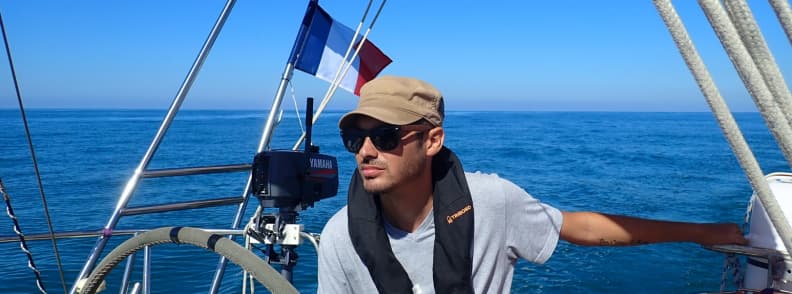
Extending the Trip with Coastal & Island Sailing
If you’re not in a rush (and most people sailing the Tuscan coast aren’t), Pisa is a pivot point destination. From here, you can turn north to Liguria, east toward Florence by land, or south to island anchorages and uncrowded ports. We left Nautica 180 Pisa after three days of stillness, and the open sea felt new again.
Here’s how to stretch your route from Pisa into something even better.
Sailing from Cinque Terre to Pisa (and Beyond)
If you’re arriving from the north like we did, the route between Cinque Terre and Pisa is calm in the mornings, with predictable weather patterns in summer. We passed Portovenere, skirted Viareggio, and came down toward Bocca d’Arno without stress. Early departure and low swell made it smooth.
After Pisa, you’ve got options.
- Livorno is a short hop south, with a full-service marina and good provisioning.
- San Vincenzo is smaller and quieter, but a good stop if you’re continuing toward the islands.
- Piombino gives you a mainland launch point for Elba and the Tuscan Archipelago.
Sailing tip: Don’t underestimate Livorno. It may seem industrial, but the food scene is legit, and the central market is great for restocking before longer legs.
Island Hopping from the Tuscan Coast
One of the most overlooked parts of sailing holidays Italy northern Mediterranean is how reachable the islands are from Pisa.
- Elba is only 30–35 nautical miles from the coast. Plenty of anchorages, great for kids, and rich in hiking and snorkeling.
- Capraia is further out. This wilder, less developed Italian island is often skipped. That’s exactly why you should go.
- Giglio and Giannutri, further south, are better for experienced crews or longer stays.
Our trip continued south, and we ended up spending several days on Elba. It’s one of the most reliable early- or late-season stops. Warm water, protected coves, and space to breathe.
Local sailing tip: If you have three days after Pisa, head to Elba with an overnight stop in San Vincenzo. Anchor off Porto Azzurro or moor in Marciana Marina. Both are welcoming, with easy access to supplies.
Building a Loop Itinerary Around Pisa
If you’re planning a loop for a Mediterranean sailing itinerary including Pisa, here’s a rough outline that works well for a two-week trip:
- Portovenere (start)
- Viareggio (stop if you want seafood and nightlife)
- Pisa / Arno River
- Livorno
- Elba
- Return via San Vincenzo or Cala de’ Medici.
This route gives you a mix of culture, quiet anchorages, and reliable marinas. And if you’re sailing with a small child, the daily distances stay under 30 NM. It’s short enough to keep stress low and naps uninterrupted.
This is where we left Pisa behind. With full water tanks, ripe figs, and the memory of river mist still hanging behind us, we slipped back into the sea and set the bow south.
No matter which way you sail from Pisa, leave early. The wind builds fast after 11 AM, and the Ligurian Sea doesn’t like to be underestimated.
After going up the Arno River to visit Pisa, check out these blog posts from our Med sailing trip
Ligurian Sea Sailing: Epic Journey from Cinque Terre to Marina del Fezzano
Anchoring at Night: Experiencing the Tranquil Beauty of Chiavari, Italy
Genova Italy: Sailing into the Extraordinary Heart of Liguria

